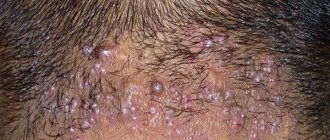Author: Sozinova A.V., obstetrician-gynecologist, has been in continuous practice since 2001.
Herpes is a viral disease that is characterized by specific rashes on the lips or genitals, as well as on other areas of the skin and mucous membranes.
Once infected, the virus remains in the body forever; it is impossible to cure it completely, but symptoms and external manifestations can be eliminated. Pronounced signs of herpes appear when immunity decreases.
There are 2 types of this virus:
- HSV-1 (herpes simplex virus). It affects the patient's lips, which is why it is called labial.
- HSV-2 (genital). Affects the genitals.
HSV-1 is not dangerous; it is one of the most common infections. And type 2 virus has a negative effect during pregnancy. It is important to be screened for infections at the stage of pregnancy planning. With timely detection of the disease and adequate treatment, it is possible to avoid adverse consequences.
Causes
The herpes virus is transmitted from an infected person. Infection can occur either from a patient with severe symptoms or in a latent (asymptomatic) stage. The virus can be contained in all biological secretions of the patient (saliva, semen, contents of rashes, etc.).
Infection can occur in the following ways:
- airborne (through a kiss);
- contact and household (dishes, medical instruments, toys, etc.);
- sexual;
- transplacental (from mother to fetus during pregnancy);
- vertical (during childbirth);
- parenteral (through blood, for example, during transplantation of infected organs, blood transfusion, IVF).
Genital herpes can be primary and secondary (repeated manifestations, relapse).
The course of the disease can be normal (rashes in certain places) or severe (spread throughout the body).
Symptoms of herpes virus infection
HSV-1 and HSV-2 have similar symptoms:
- burning and itching in the affected areas;
- the appearance of vesicles (bubbles) with liquid transparent contents after burning and itching. After a few days, these rashes open and their contents flow out, forming ulcers;
- increased body temperature (up to 38-39 degrees);
- general weakness, malaise.
A significant feature of herpes is the transition to a latent state (into “hibernation”) with further activation when the immune system is weakened. Once it enters the body, the virus lives in it throughout its entire life. During the latent period, the virus is not dangerous.
During primary infection, the period of severe symptoms is 15-16 days on average. And the duration of relapses is 8-10 days.
There is also an asymptomatic course of the disease (less commonly). This is when there are no signs of the disease, but the virus is released into the environment. That is, it is possible to infect another person.
Genital herpes (HSV-2)
With genital infection, vesicles can appear on the labia, vagina, anus and cervix.
Secondary herpes differs from primary herpes in that the symptoms are less pronounced. Relapse during pregnancy occurs due to a decrease in the woman’s immunity.
Herpes zoster
This is a severe and dangerous form of the disease during pregnancy. Characterized by unilateral skin rashes (located on one side of the body). With herpes zoster, the virus is localized in the patient’s nerve cells, which causes pain in the affected areas.
The encircling form can be of different types:
- motor (muscles are affected);
- ophthalmological (eye damage);
- Ramsay-Hunt syndrome (damage to the facial nerve, causing facial paralysis);
- hemorrhagic (vesicles contain hemorrhagic contents instead of serous transparent);
- abortive (instead of blisters, erythema and edema are formed);
- blistering (larger rashes form);
- gangrenous (deeper ulcers develop and leave a scar).
Depending on the type of herpes zoster, manifestations may vary. But they are always similar in that the rashes appear on one side (along the nerve trunks). There is also general malaise, fever, weakness, pain in the areas of the rash.
Vesicles do not appear immediately; their appearance is preceded by pinkish spots. After opening the bubbles, ulcers with crusts form in their place, which will later disappear.
An important aspect of the body's defense system against viruses and microbes
In the process of evolution, humans have developed various defense mechanisms that allow them to resist various infections. Thus, the interferon system IFN is one of the most important factors of the body’s resistance, participating in various immunological reactions. Interferons are a group of biologically active proteins or glycoproteins synthesized by the cell in the process of a protective reaction to foreign agents, which include viral infection. Currently, the concept of “interferon system” (SI) has emerged. It does not belong to any specific organ, but exists in every cell, so all of them can be infected with a virus and must have a system for recognizing and eliminating foreign genetic information. SI is configured to recognize “self and foe” and is “built-in” into almost all cells of the body, which allows it to actively influence the entire cascade of the body’s defense reactions from phagocytosis to inflammation, which makes it an important factor in nonspecific resistance. As a result of the study of interferons, their role was determined: control and self-regulation of processes in the body. The main effects of interferon protection: antiviral, antimicrobial, immunomodulatory, preventing excessive cell proliferation, protection against radiation and others. Herpesvirus infections cause an imbalance in the interferon system, inhibit the cellular and phagocytic reactions of the body (prevent the detection, absorption and removal of viral particles). Restoration and normalization of the body’s defense mechanisms is the preventive task of antiviral therapy.
Diagnostics
Diagnostic measures:
- Anamnesis. If a woman has previously suffered from herpes, this should be reported to the gynecologist who is caring for the pregnancy. This will prevent the development of complications.
- Examination of the skin and mucous membranes, including vaginal examination using speculum. The doctor will be able to detect the presence of vesicles or sores.
- Laboratory tests (PCR, serological method). Blood or the contents of vesicles are used as biological material.
- During pregnancy, the presence of specific IgG in the blood serum (avidity index) is determined. If this index is less than 30%, then this indicates an acute primary form, more than 40% indicates a chronic (secondary) form.
Differential diagnosis
Herpes must be differentiated from:
- primary syphilis (mostly single erosion with clear boundaries is formed);
- dermatitis (skin inflammation, irritation);
- chicken pox.
Conclusion:
inflammatory changes in the reproductive organs of women with infertility are mainly a consequence of CHI (chronic herpesvirus infections). Herpes viruses and the factors they produce cause inflammation of the mucous membranes, destruction of the epithelium of the reproductive organs and suppression of the humoral immune system - all this leads to impaired fertility and infertility. In the Russian Federation we are talking about millions of patients.
Currently, according to epidemiological studies, up to 90% of the population is infected with the herpes simplex virus (HSV). Fortunately, despite this, the overall increase in fertility on the planet is still positive.
Treatment of herpes during pregnancy
The goal of treatment is to eliminate severe symptoms and reduce relapses. During pregnancy, therapeutic measures are aimed at preventing infection of the child.
For primary infection and relapses, the doctor prescribes Acyclovir. The duration of treatment is 5-7 days. Pregnant women with herpes zoster are subject to hospitalization.
Acyclovir is also used to treat newborns, but intravenously.
Delivery in the presence of herpes
Severe symptoms of genital herpes after the 36th week of pregnancy and during childbirth serve as an indication for cesarean section.
How to behave if the disease manifests itself
Speaking about household habits, it is worth noting that hand hygiene during a relapse of herpes is very important. Do not touch the affected area with your hands, because the infection can be transferred from the face to the genital area. Infection of the birth canal before childbirth may lead to a caesarean section. Herpetic infection in pregnant women requires mandatory treatment under the supervision of a specialist. If a pregnant woman is surrounded by someone with signs of infection, close contacts should be avoided: kissing, sex, and you should not share dishes, linen, or towels with the patient.
Possible consequences for mother and child
Primary infection with genital herpes during pregnancy increases the risk of infection of the fetus.
Possible complications include:
- intrauterine infection of the fetus;
- miscarriage, miscarriage (in the 1st trimester);
- premature birth, prematurity;
- fetal malformations (encephalitis, hydrocephalus, etc.).
Herpes of the first type (labial) does not cause complications or concerns. But local therapy is still necessary.
Neonatal herpes of the newborn
Infection of a child with primary herpes occurs in approximately 50 cases out of 100, with secondary herpes - much less often. Neonatal herpes poses a risk to the health of the newborn. Therefore, it is necessary to remind once again how important it is to be examined at the stage of pregnancy planning and to undergo timely treatment at the first symptoms of the disease.
Features of herpes in newborns:
- infection in the womb occurs less frequently, mainly at the time of birth, passing through the mother’s birth canal;
- the development of primary herpes in the mother, especially closer to childbirth, increases the risk of the disease in the child;
- Symptoms of neonatal herpes can occur immediately after birth, sometimes after 5 weeks from birth.
Forms of neonatal herpes:
- generalized. The skin (sometimes mucous membranes) of the child is affected, as well as the liver, nervous system and other organs;
- damage to the central nervous system (CNS). There are no skin rashes;
- encephalitis or hydrocephalus (brain damage);
- damage to the oral cavity and conjunctiva without involving the central nervous system and internal organs.
Infection of a child can also occur after childbirth, through touching an infected mother.
The disease often begins unexpectedly and without obvious symptoms of herpes. The newborn eats poorly, and there is increased tearfulness and irritability. After which the body temperature rises and respiratory problems appear. The skin may show jaundice and hemorrhagic diathesis (point hemorrhages). Most newborns do not develop rashes.
Important! It is very important to recognize neonatal herpes in time, since if left untreated it can cause irreversible consequences. You must contact your pediatrician immediately if there are any deviations from the norm or changes in the child’s behavior, and you must also inform the mother about the presence of herpes.
Effects of therapy with VIFERON
“The use of the drug VIFERON® from the 14th week of pregnancy contributed to:
– exclusion of signs of hematogenous infection;
– reducing the frequency of ascending infection by 4.5 times;
– reducing the incidence of pathology in newborns (infectious and non-infectious);
– exclusion of structural changes in the central nervous system in newborns;
– increasing the frequency of births of healthy children by 2 times [1];
According to available data: “The inclusion of the drug VIFERON® in complex therapy helps reduce:
– threats of termination of pregnancy 2 times;
– polyhydramnios and oligohydramnios by 3 times;
– gestosis by 2.5 times;
– the frequency of replicative forms of the virus is 2 times (HSV from 79.3% to 45%, CMV – from 62.2% to 33.3%);
– the frequency of relapses of concomitant bacterial vaginosis is more than 1.5 times (mycoplasma and ureaplasma);
– the total number of non-infectious complications of the perinatal period by 2.5 times (from 28.6% to 12%)
– the total number of cases of IUI in newborns increased 5 times (from 26.7% to 5.2%);
– the incidence of severe forms of IUI doubled (from 25% to 11.3%) [2].
Reference and information material
Author of the article
Belyaev Dmitry Alexandrovich
General doctor
Sources:
- Bocharova I.I., Novikova S.V., Malinovskaya V.V., Vyzhlova E.N., Parfenov V.V. Perinatal aspects of herpesvirus infections // Medical Advisor. Gynecology. 2022.1/(41).
- IN AND. Krasnopolsky, T.G. Tareeva, V.V. Malinovskaya. Monitoring of pregnant women with viral infections of the herpes family // Medical technology. – M. 2016. – 40 p.
i https://www.lvrach.ru/
ii https://medi.ru/
Loading...
Take other surveys









